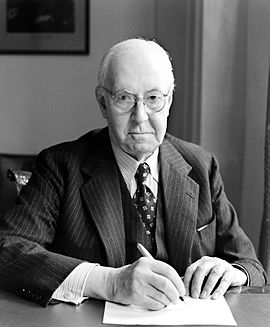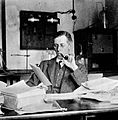Henry Hallett Dale facts for kids
Quick facts for kids
Henry Dale
|
|
|---|---|
 |
|
| Born |
Henry Hallett Dale
9 June 1875 |
| Died | 23 July 1968 (aged 93) |
| Education | Tollington School The Leys School |
| Alma mater |
|
| Known for |
|
| Awards |
|
| Scientific career | |
| Fields | |
Sir Henry Hallett Dale (born June 9, 1875 – died July 23, 1968) was an English scientist. He studied how medicines affect the body (pharmacology) and how living things work (physiology). He is famous for his work on a special chemical called acetylcholine. This chemical helps nerve signals travel in the body. For this important discovery, he won the 1936 Nobel Prize in Physiology or Medicine with Otto Loewi.
Contents
Early Life and Education
Henry Hallett Dale was born in Islington, London. His father, Charles James Dale, made pottery. His mother, Frances Anne Hallett, was the daughter of a furniture maker. Henry was one of seven children. His younger brother, Benjamin Dale, became a well-known composer.
Henry went to Tollington Park College and then The Leys School in Cambridge. One of the houses at The Leys School is named after him. In 1894, he started studying at Trinity College, Cambridge. There, he worked with a physiologist named John Langley. In 1903, he also studied for a few months in Germany with Paul Ehrlich. Henry Dale earned his Doctor of Medicine degree from Cambridge in 1909.
Career and Important Discoveries
While working at the University College London, Henry Dale became good friends with Otto Loewi. In 1914, Dale became a director at the National Institute for Medical Research in London. He led the Department of Biochemistry and Pharmacology. Later, in 1942, he became a professor of chemistry at the Royal Institution. During World War II, he advised the government on scientific matters.
Understanding Nerve Signals
In 1914, Dale and his team found a chemical called acetylcholine. They thought it might be important for sending messages in the body. Later, Otto Loewi showed how important this chemical really was in the nervous system. Because of their amazing work on how nerve signals are sent, Dale and Loewi shared the 1936 Nobel Prize in Medicine.
During the 1940s, scientists debated how nerve cells communicate. Dale believed that nerve cells talked to each other using chemicals. Other scientists, like John Carew Eccles, thought it was done with electricity. We now know that most nerve signals are sent using chemicals. However, some nerve connections do use electricity.
Dale's Principle
Henry Dale also came up with a way to group nerve cells (neurons). He grouped them based on the chemicals they release. For example, neurons that release noradrenaline are called noradrenergic neurons. Neurons that release GABA are called GABAergic. This idea is known as Dale's principle.
One early idea from Dale's principle was that each neuron releases only one type of chemical messenger. However, scientists later found that many neurons can release more than one type of chemical. This is called "coexistence principle."
From 1938 to 1960, Dale was the chairman of the Wellcome Trust. This is a large charity that supports health research.
Awards and Honors
Henry Dale received many awards for his scientific work. In 1914, he became a Fellow of the Royal Society (FRS). He was given the Cameron Prize in 1926. In 1932, he was made a knight. He also received the Knight Grand Cross of the Order of the British Empire in 1943. In 1944, he was given the Order of Merit.
He was the president of the Royal Society from 1940 to 1945. He also led the Royal Society of Medicine from 1948 to 1950. Today, the Sir Henry Dale Fellowships from the Wellcome Trust are named after him. The Society for Endocrinology also gives out the Dale Medal each year in his honor.
Personal Life
In 1904, Henry Dale married his cousin, Ellen Harriett Hallett. They had one son and two daughters. One of their daughters, Alison Sarah Dale, married Alexander R. Todd. He also won a Nobel Prize and was a President of the Royal Society. The Dale family lived at Mount Vernon House from 1919 to 1942. A special blue plaque was put on the garden wall of their house in 1981 to remember his time there.
Images for kids
See also
 In Spanish: Henry Hallett Dale para niños
In Spanish: Henry Hallett Dale para niños








